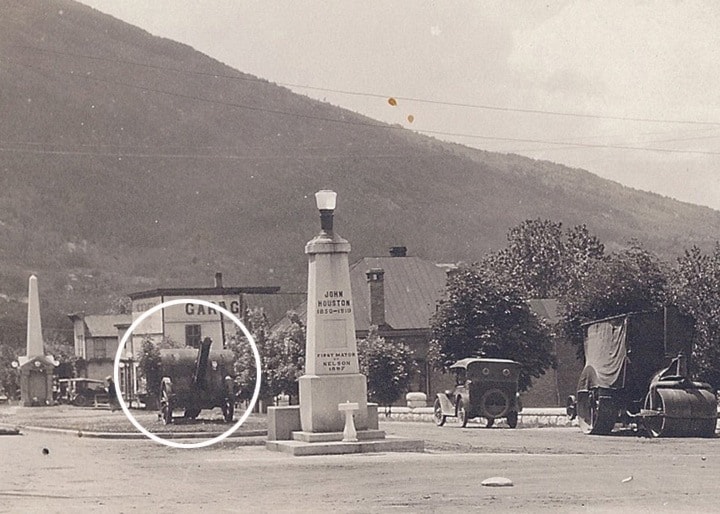Seventh in an occasional series of urban oddities
You could have fired a cannon down Vernon Street in the 1920s and ‘30s — assuming it still worked. During those years, a German howitzer from the First World War sat on the boulevard in front of the Hume Hotel, one of thousands of such trophies found across Canada.
The idea first surfaced in the Nelson Daily News of November 25, 1915, when prominent fruit rancher J.T. Bealby commented on a proposal to create a war memorial: “A suitable position ... would be the sides and plinth of the John Houston memorial, but a better monument still would be one of the cannon[s] captured from the Germans (there will be plenty of them before the war is over) which could be placed in a public thoroughfare of the city ...”
Although Bealby’s suggestion wasn’t acted on immediately, following the 1918 armistice, the federal government created a war trophy commission to recommend a policy for distributing captured German weapons for display. There were lots to go around: more than 500 guns and howitzers, over 300 trench mortars, 2,500 heavy and light machine guns and 3,000 rifles.
The rarest items were set aside for national and provincial war museums, a certain number were reserved for provincial capitals, and the rest were distributed to each province based on wartime enlistments. BC, which provided 10 per cent of the total Canadian Expeditionary Forces enlistment, received 250 pieces.
It’s not clear when the 150-calibre howitzer arrived in Nelson, but we know it was one of five guns captured by the 54th Kootenay Battalion on September 27, 1918 on the road near Bourlon Wood, France. By late March 1921, Nelson had a gun park on Vernon Street when “another allotment” arrived, consisting of two ammunition boxes and two machine guns, numbers 5178 and 858.
Lt.-Col. Archibald Douglas, director of war trophies, wrote to the city: “These trophies, which have been declared the property of the people of Canada, are sent to you with the understanding that proper care will be taken of them.”
The Daily News said it hadn’t been determined if the acquisitions would be added to the gun park. Neither the howitzer nor machine guns were mentioned when the cenotaph was unveiled on Vernon Street in November 1922 (the latter was moved decades later to its present location in front of city hall). However, according to records at the National Archives, Nelson received a second large gun — captured in 1918 by the 7th Battalion west of Villers-Lez-Cagicourt — and a total of four machine guns.
It’s not known where they were displayed, though longtime resident Alan Ramsden recalls a field gun at the west end of the Vernon Street boulevard with platforms on either side for people to sit.
Other local communities had trophies too: Trail, Rossland, Greenwood, Grand Forks, Nakusp, Creston, Silverton, Kaslo, and Edgewood each received allotments of trench mortars and guns.
So what became of these World War I spoils? Ramsden says they were lost to the scrap metal drives of World War II. “There was this big request for steel, so they had them dismantled and shipped off to make new guns,” he says. “Back east, they were looking for metal that was easier to smelt down than to go out, mine ore, and start from scratch.”
War trophies weren’t the only targets. “A lot of metal was collected and guys made quite a good living for a while going to old mines and taking out rails and old treatment plants no longer being used,” Ramsden says.
He isn’t sure where the scrap actually went, but figures the howitzer and its companion were removed about 1940. Similar fates probably befell most of the trophies in neighbouring towns, although a field gun that was part of Rossland’s war memorial didn’t even make it that far — it was destroyed in a 1929 fire.
A few pictures of the Nelson howitzer exist: it appeared on the front page of the Daily News in 1929 when renovations to the Hume Hotel were completed, and on a couple of postcards issued in the 1930s.
Thanks to Sylvia Crooks, Shawn Lamb, Alan Ramsden, Greg Scott, and the CEF Study Group
Previous installment in this series
